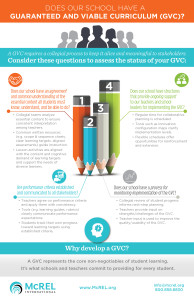
During our consultation with this principal, we asked her if she knew whether the school has a guaranteed and viable curriculum (GVC). She wasn’t sure how to answer, so she responded with a question, “How would I know if the school has a guaranteed and viable curriculum?”
To determine whether a school has a GVC, we must first describe it. A “guaranteed” curriculum is often defined as a mechanism through which all students have an equal opportunity (time and access) to learn rigorous content. This requires a school-wide (or district-wide) agreement and common understanding of the essential content that all students need to know, understand, and be able to do. The word “all” needs emphasis; a guaranteed curriculum promotes equity, giving all children equal opportunity to learn essential content, and to provide this opportunity, curricular materials and instructional approaches must be grounded in research, implemented with fidelity, and must include vertical as well as horizontal alignment. Curriculum development is often regarded as a district function. However, schools (through teachers) implement the curriculum, and, if implementation varies significantly from teacher to teacher, then student outcomes will also likely vary significantly from classroom to classroom. These days, teachers have access to a variety of curriculum resources, such as open educational resources, playlists, digital textbooks, and teacher-developed curriculum. Having access to options is a good thing, but having many choices does not ensure all choices are well aligned to the school’s GVC.
For a curriculum to be “viable,” there must be adequate time for teachers to teach the content and for students to learn the content. A viable curriculum eliminates the supplementary or “nice to know” content. Does this mean that a GVC is a scripted, rigid curriculum? No! Does this mean that students and teachers are confined to a lockstep process of teaching and learning? Absolutely not! Teachers must have the flexibility to meet student needs through different methods of content delivery, helping students dive deeper into their passions. At its essence, a GVC represents the core non-negotiables of student learning. It’s what schools and teachers commit to providing for all students.
To help school leaders and leadership teams self-assess the “guaranteed and viable” status of their curriculum, my colleagues and I developed the following questions that can be used by any school.
1. Does our school have an agreement and common understanding of the essential content that all of our students need to know, understand, and be able to do?
A principal might find written guidance, such as scope and sequence charts, aligned common assessments, and instructional guidance to help answer this question, and although written documents offer a good place to start, these documents might not reflect implementation in the classroom. Learning how teachers plan for instruction might be more informative. Are teachers involved in collaborative planning and is student work discussed during grade-level or department meetings? Additionally, during classroom visits, are students engaged in learning experiences requiring similar levels of rigor? During collaborative planning meetings teachers ask questions such as: 1) How will this learning activity help students access the essential content?; 2) Does this activity require the level of cognitive rigor described in the standards?; and 3) How will we know that students have learned the essential content?
2. Are performance criteria established and communicated to all of our stakeholders?
Having a mutual understanding among teachers as to what student performance demonstrates mastery, partial mastery, or entry level learning of essential content is a critical component of a GVC. Without this common understanding of performance criteria, students across a grade level or course could have widely different performance expectations.
As with question 1, a principal might look for written documentation and observe teacher practice to inform this question. For example, do teachers use common tools, such as learning guides and rubrics, to share performance criteria with students/families? Do students track their own progress toward learning goals and understand their strengths and areas for improvement? Do teachers engage in calibration exercises where a group of teachers assess one piece of student work individually and then discuss variations of teacher interpretations of performance?
3. Does our school have a process for monitoring implementation of the GVC?
To answer this question, a principal might look for established routines and processes. For example, are regular meetings established to review student progress data? During student data discussions, teachers might ask questions such as: 1) Are we on track to help all students learn the essential content?; and 2) What evidence shows we’re on track? If we’re not on track, what steps should we take?
Additionally, mechanisms should be in place to obtain teacher feedback on implementation of the GVC. Feedback can be gleaned through surveys, polls, or through collegial meetings in which teacher teams discuss implementation challenges and review student progress. Most importantly, when teacher feedback is collected, how is it addressed? Teachers must know that their input is valued and acted upon.
4. Does our school have structures that provide ongoing support to our teachers and school leaders for implementing the curriculum with fidelity?
For many teachers, implementation with fidelity can be a nebulous concept, and this is where a tool such as an innovation configuration (IC) map can be quite useful. IC maps clearly articulate stages of implementation so that teachers can distinguish between high, moderate, and low implementation levels. This tool helps teachers identify their own personal level of implementation and then take steps to increase implementation fidelity.
Ongoing implementation support for teachers and school leaders might also include allocated time for collaborative planning with colleagues. In fact, such support might be in response to feedback provided by teachers. For example, if teachers find that students perceive certain curriculum topics as lacking relevance, ongoing support might include collegial time for a deep dive into that section of the curriculum. Teachers could identify ways to better engage students and help students connect personally with the topics and underlying concepts.
Establishing and maintaining a GVC is a collegial process that requires established protocols and routines to keep the GVC agreement alive and meaningful to all stakeholders. It requires open dialog about learning activities, performance criteria, and student progress as well as the willingness of each stakeholder to reflect on their contribution to the process.

A quality curriculum review will help your school or district refine its areas of effectiveness and identify high-leverage opportunities for improvement. McREL can help you ensure alignment of your curriculum, instruction, assessments, and standards, and can help you build the processes and protocols to make a GVC a reality in your schools. Learn more.


Hi-
I want to explore whether my school has this GVC- and I want to see if you have folks that can come and help us.
Please contact me- I will need to know how much time you need and what your fees are-
Thank you!
Michael
Michael, we certainly can help your school with a GVC analysis and recommendations. We will have one of our experts contact you right away.
Hi,
We are working towards a GVC for our K-12 School district. We have always said our curriculum is the standards. We have prioritized and created proficiency scales. Is the next step common materials? We are getting some push back from HS teachers wondering why we need common materials, if the standards are the curriculum. Are you able to help us support “the why?”
Thank you,
Jodi
K-12 Instructional Coach
Hi Jodi – Thanks for the question. Basing your district curriculum on the standards and creating proficiency scales are two important steps toward building a GVC. As you read in the blog, developing teacher teams that consistently work together to refine/improve teaching and learning is another step, and having common resources helps to move collaborative teams forward. Having common resources tends to promote collaborative planning and common student work products which in turn establishes the focus for grade level or course PLCs. This collaboration helps ensure that learning activities and assessments are aligned to both the content and cognitive demand of the standards which tends to keep expectations high for all students. I’m currently working with a high school district, and content areas (English language arts, math, science, social studies) are at varying stages toward implementation of standards. One content area uses a quality common resource, and their conversations about teaching and learning are different from the other content areas. They dig into the details of lessons and rubrics. They discuss student work, and they work as a team to overcome the learning challenges faced by their students. They are still individually creative teachers, but they have a common frame of reference. According to teacher leaders, the transition to a common resource had its challenges, but the effort was worth it, and their students are benefitting. Should you decide to move forward with common resources, establishing an in-depth process for materials review and selection is critical. Having a common resource is another step toward a GVC, but if the resource is not well aligned to standards, student progress may be stymied.
We have our LCT meetings where we discuss the content standards and how we are ensuring students are learning what is being taught. We do not go over student work much or have much time to discuss what is going on in our classrooms. Should we work on making more time to collaborate about what is working in our classrooms and what is not working? Focusing on academic standards, curriculum, and instruction.
Hi Jennie – Thanks so much for your question. Working as a team to focus on standards, curriculum, and instruction together is a productive learning activity for instructional teams and examining student work opens the discussion of all three. I find that individual teachers interpret standards somewhat differently, so bringing student work to the discussion makes it more concrete and helps clarify misconceptions. I encourage teachers to identify a few standards that are problematic – ones that are challenging to assess, teach, learn. We agree as a group to bring in 2-3 pieces of student work and discuss how the work aligns to the standard, whether the task provides sufficient data to inform next steps, and what student feedback or instructional moves might best serve the learner. The discussion is typically quite rich and centered around what happens in the classroom. Using student work allows teachers to point to evidence of both bright spots and places where students seem to struggle, and this typically opens opportunities to share how teachers are supporting learning. There are a few logistics to work out. For example, depending on the size of the team, you might have teachers initiate the discussion in pairs or triads so that everyone is involved. I would also suggest that work samples come from classwork activities, exit tickets, or short quizzes rather than longer assessments. The work should primarily reflect the selected standard.
Article is helpful for implementing guaranteed and viable curriculum at teaching institution level.